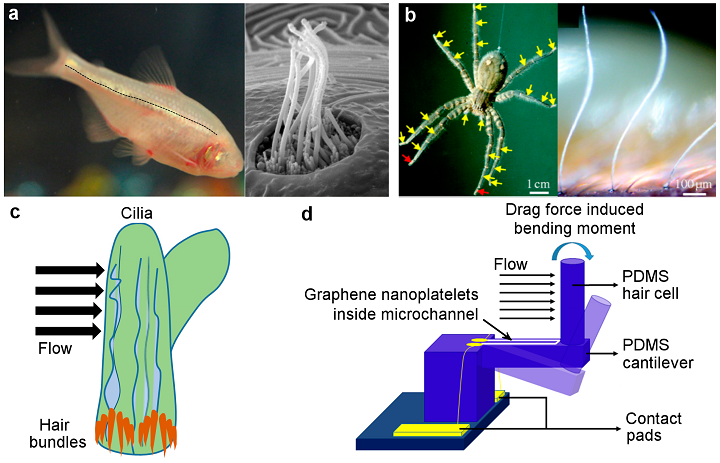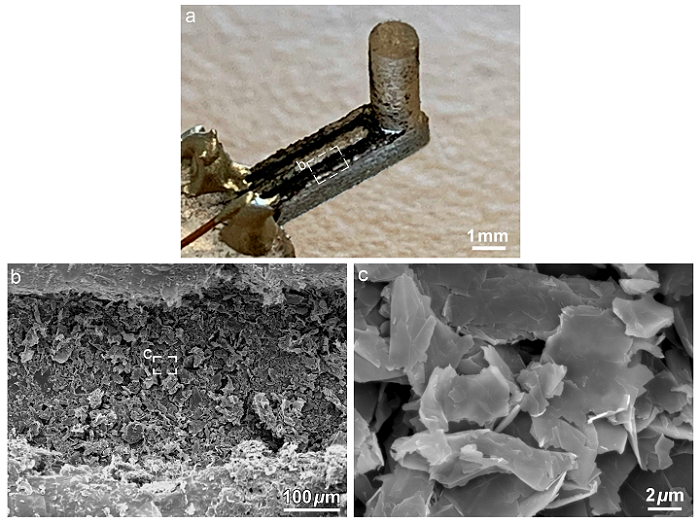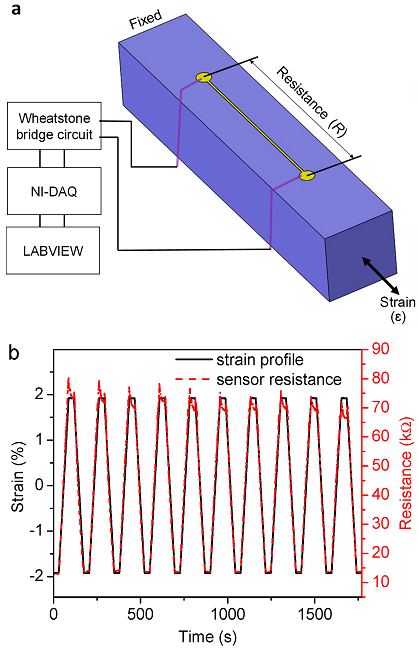
Biomimetic flow sensing: (a) lateral line sensors on fish skin (black line) containing hair-like cilia bundles (credit: Prof. Andrew Forge) for water flow sensing; (b) hair-like sensilla on spider legs (reprinted with permission from [14], Copyright The Royal Society, 2008); (c) schematic of flow-induced bending of cilia bundles encapsulated by a protective cupula; and (d) sensing principle of bioinspired sensor comprising hair cell and cantilever used in this work.
What Mother Nature has already created, we humans are bound to try and recreate; case in point: biological sensors. Thanks to good old biomimicry, researchers have made their own artificial sensing systems based on designs already found in nature, like olfactory sensors in sharks, wake sensing whiskers in seals, thermal sensors in beetles, acoustic sensors in the inner ear, etc. Extremely sensitive cilia structures in nature perform MEMS flow sensing activities – this is why crickets can detect extremely low airflow velocities and spider legs are very sensitive to low air flow perturbation energies.
A trio of researchers from the University of Groningen and MIT recently published a paper, titled “Bioinspired Cilia Sensors with Graphene Sensing Elements Fabricated Using 3D Printing and Casting,” about their new “processing paradigm” for easier fabrication of flexible sensors that have bio-inspired structures. In the past, artificial MEMS cilia sensors were created with traditional micro/nano fabrication processes, using SU-8 polymer or silicon embedded with piezoelectric or piezoresistive sensing elements. However, these processes were rife with issues, top of the list being the lack of an ultra-sensitive material to mimic cilia.
“The proposed fabrication workflow entailed 3D-printing a metallic mold with complex and intricate 3D features such as a micropillar and a microchannel, casting polydimethylsiloxane (PDMS) inside the mold to obtain the desired structure, and drop-casting piezoresistive graphene nanoplatelets into the predesigned microchannel to form a flexible strain gauge,” the researchers wrote.

Schematic of fabrication process flow involving metal SLM 3D printing, PDMS casting, and graphene infusion into microchannel. SLM process schematic (Image I) reprinted with permission from [54], Copyright Elsevier, 2019.
Using their novel processing methodology, Amar M. Kamat, Yutao Pei, and Ajay G.P. Kottapalli designed and created a cilia-inspired flow sensor, which used PDMS as the sensor structure and graphene nanoplatelets (GN) as the piezoresistive sensing elements. They did not physically 3D print the sensor structure; instead, they cast PDMS into a stainless steel mold, 3D printed on an SLM Solutions 125HL, to make the structure itself.
“The bioinspired sensor design comprised an all-PDMS cantilever-pillar structure with a GN piezoresistor deposited on the cantilever surface,” the researchers explained. “The drag force-induced bending of the pillar, and thereby the cantilever, due to flow was sensed by a change in resistance of the piezoresistive sensing elements (i.e., GN) located inside the microchannel.”
Once the PDMS solution was prepared, diluted conductive graphene dispersion was drop cast into the microchannel on the cantilever’s surface. Thanks to the capillary effect, the GN solution flowed easily and, once it had dried, formed a thin film on the PDMS substrate. Conductive silver paste was used to make electrical connections at the ends of the microchannel, and the GN sensing elements were then “homogeneously distributed inside the microchannel and contacted each other.”
“Since the GN strain gauge present on the top surface of the cantilever forms the fundamental piezoresistive sensing element, the determination of its gauge factor (GF) is a crucial step towards the sensor characterization,” the researchers wrote.

(a) optical micrograph of the developed sensor, (b) SEM image of GN inside the microchannel and (c) high magnification SEM image showing the morphology of GN sensing elements.
They conducted uniaxial tension-compression tests in order to characterize the strain gauge, and then performed oscillatory and steady-state tests in both air and water to gauge how sensitive the cilium sensor was for flow and touch stimuli.
“The graphene-on-PDMS strain gauge showed a high gauge factor of 37 as measured via cyclical tension-compression tests,” the researchers wrote.
“The sensor showed good sensitivity against both tactile and water flow stimuli, with detection thresholds as low as 12 µm in the former and 58 mm/s in the latter, demonstrating the feasibility of our method in developing flexible flow sensors.”
The measured GF (gauge factor) was pretty high, which the team says demonstrates the high potential their process has for making flexible graphene-on-PDMS strain gauges.

Gauge factor measurement: (a) schematic of tensile test setup to measure resistance for an applied strain (blue: PDMS, yellow: graphene); and (b) applied strain profile and measured resistance change for 10 tension-compression cycles.
In addition to the team’s low-cost, repeatable method, the researchers also have other original aspects in their work, like:
- the use of GN as a piezoresistive sensing element for flow sensing
- the creation of high sensitivity in bioinspired MEMS flow sensors through flexible sensor structures and high-GF graphene sensing elements
“The fabrication methods described in this work alleviate the cumbersome and expensive multilayer deposition and lithography steps required to fabricate complex 3D structures (e.g. high-aspect ratio pillars) and/or intricate features (e.g. microchannels). The proposed methodology also allows the possibility of using a wide range of polymer materials for MEMS fabrication. Finally, the 3D printing and casting approach described in this work can potentially pave the way to the development of other biomimetic 3D-printed sensor structures in the future,” the researchers concluded.

Sensor tests: (a) oscillatory tactile stimuli; (b) example of FFT peak at 35 Hz for d = 205 µm; (c) compressed air stimuli along X-axis; (d) respiratory exhalation along Y-axis; (e) oscillatory flow stimuli in DI water (RMS velocity sweep); (f) oscillatory flow stimuli in DI water (frequency sweep).
They believe that their fabrication method is promising in terms of batch fabrication of flexible electronics. Next, the researchers will work to optimize and miniaturize their sensor’s design, in addition to improving their drop-casting method so they can achieve repeatable, uniform thin film characteristics.
Discuss this and other 3D printing topics at 3DPrintBoard.com or share your thoughts in the comments below.
Subscribe to Our Email Newsletter
Stay up-to-date on all the latest news from the 3D printing industry and receive information and offers from third party vendors.
You May Also Like
Further Understanding of 3D Printing Design at ADDITIV Design World
ADDITIV is back once again! This time, the virtual platform for additive manufacturing will be holding the first-ever edition of ADDITIV Design World on May 23rd from 9:00 AM –...
3D Printer Maker EVO-tech Reborn as NEVO3D — Once More With Feeling
EVO-tech was a 3D printing service and original equipment manufacturer established in 2013 and based in Schörfling am Attersee, Austria. The company produced high-quality material extrusion systems featuring linear bearings,...
3D Systems Brings 3D Printed PEEK Cranial Implant to the U.S. with FDA Clearance
For more than 10 years, 3D Systems (NYSE:DDD) has worked hand-in-hand with surgeons to plan over 150,000 patient-specific cases, and develop more than two million instruments and implants from its...
CDFAM Returns to Berlin for Second Annual Symposium
The second CDFAM Computational Design Symposium is scheduled for May 7-8, 2024, in Berlin, and will convene leading experts in computational design across all scales. Building upon the first event...































